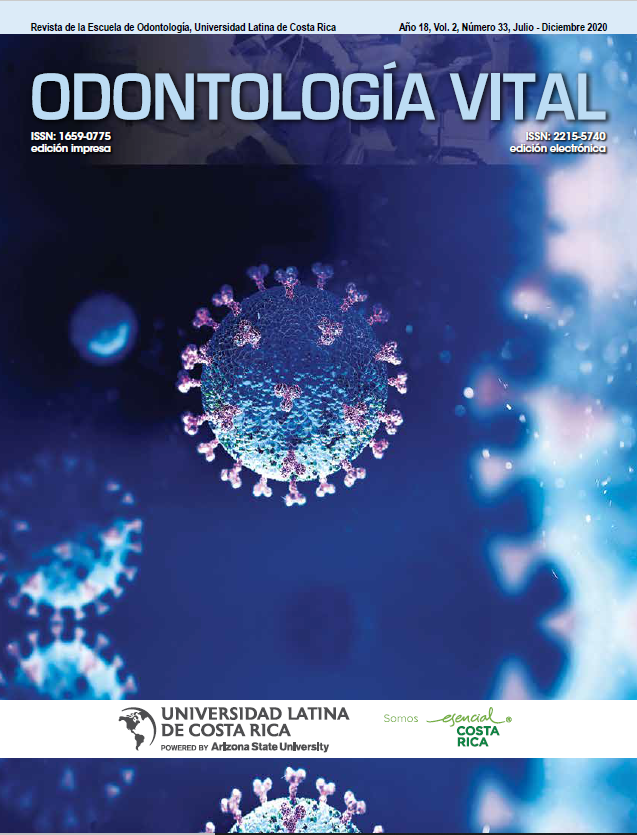Deflection of dental needles 30G: comparison of five trademarks
DOI:
https://doi.org/10.59334/ROV.v2i33.399Keywords:
Deflection, needle, dental anesthesia, needle injury, anesthesia effectiveness, needle flexibilityAbstract
Introduction: The degree or level of deflection of the dental needle, in most cases, can determine the success or failure of the dental anesthesia technique.
Objective: measure the degree of deflection of the dental needle, comparing 5 different brands available in the city of Hermosillo, Sonora, Mexico.
Method: An experimental study was carried out, with a model created with a professional level and a carpul syringe, various punctures were made in a piece of beef, simulating the performance of a linear technique of oral anesthesia. Periapical radiographs of each of the punctures were taken, and with the help of a millimeter mesh, measurements were made. Within each group of needles, different deflection measures were presented, and an average of each brand was obtained. The range ranged from .65 mm to 2.1 mm of deflection, taking as reference a straight plane.
Conclusions: It was shown that the Septodont® brand was the one that presented the lowest puncture deflection. It is advisable to verify and examine the condition of the needles before being used to perform surgical procedures, and thus reduce risks and / or postoperative complications.
Downloads
References
Aldous, J. A. (1968). Needle deflection: a factor in the administration of local anesthetics. The Journal of the American Dental Association, 77(3), 602-604. https://doi.org/10.14219/jada.archive.1968.0278
Allen, G.D. (1989). Anestesia y analgesia dentales. Limusa- Noriega.
Cooley, R. L., & Robison, S. E (1979). Comparative evaluation of the 30-gauge dental needle. Oral Surgery, Oral Medicine, Oral Pathology and Oral Radiology, 48(5), 400-404. https://doi.org/10.1016/0030-4220(79)90065-3
Delgado-Molina, E., Tamarit Borras, M., Berini Aytés, L, & Gay Escoda, C. (2009). Comparative study of two needle models in terms of deflection during inferior alveolar nerve block. Medicina Oral, Patología Oral y Cirugía Bucal, 2009, vol. 14, num. 9, p. 440-444.
Gaitan- Fonseca, C., Romo-Castillo, D„ Cerda-Cristema, B., Masuoka, D., & Pozos- Guillen, A. (2015). Bevel Tip Deformation in New and Used Dental Needles. Microscopy Research, 3(01), 1. https://doi.org/10.4236/mr.2015.31001
Hochman, M. N, & Friedman, M. J. (2000). In vitro study of needle deflection: a linear insertion technique versus a bidirectional rotation insertion technique. Quintessence International, 31(1).
Jay Davidson, M. (1989). Bevel-oriented mandibular injections: needle deflection can be beneficial.
Jeske, A.H.,& Boshart, B. F. (1985). Deflection of conventional versus non-deflecting dental needles in vitro. Anesthesia progress, 32(2), 62.
Kennedy, S., Reader, A, Nusstein, J., Beck, M., & Weave/; I. (2003). The significance of needle deflection in success of the inferior alveolar nerve block in patients with irreversible pulpitis. Journal of endodontics, 29(10), 630-633. https://doi.org/10.1097/00004770-200310000-00004
Lehtinen, R. (1983). Penetration of 27-and 30-gauge dental needles. International journal of oral surgery, 12(6), 444-445. https://doi.org/10.1016/S0300-9785(83)80036-2
Leyva López, V. G., Luna Lara, C. A., Quesada Castillo, J. A., Téllez Jiménez, H, & Parra, R. O. (2013). Estudio in vitro de la deflexion de agujas 30G y27G con tres diferen tes técnicas de inserción. Revista ADM, 70(2).
Ng, K.W., Goh, J. Q., Foo, S. L„ Ting, PH., Lee, T K., Esuvaranathan, K., ... & Chiong, E. (2013). Needle deflection studies for optimal insertion modeling. International Journal of Bioscience, Biochemistry and Bio informatics, 3(6), 570. https://doi.org/10.7763/IJBBB.2013.V3.278
Robison, S. E, Mayhew, R. B., Cowan, R. D., & Hawley, R.J. (1984). Comparative study of deflection characteristics and fragility of 25-, 27-, and 30-gauge short dental needles. The Journal of the American Dental Association, 109(6), 920-924. https://doi.org/10.14219/jada.archive.1984.0246
Steele, A.C., German, M.J., Haas, J., Lambert, G., & Meechan, ,J. G. (2013). An in vitro investigation of the effect of bevel design on the penetration and withdrawal forces of dental needles. Journal of dentistry, 41(2), 164-169. https://doi.org/10.1016/j.jdent.2012.10.016
Steinkruger, G., Nusstein, J., Reader, A, Beck, M., & Weaver, J. (2006). The significance of needle bevel orientation in achieving a successful inferior alveolar nerve block. The Journal of the American Dental Association, 137(12), 1685-1691. https://doi.org/10.14219/jada.archive.2006.0114
Wittrock, J. VE, & Fischer, W. E. (1968). The aspiration of blood, through small-gauge needles. The Journal of the American Dental Association, 76(1), 79-81.
Downloads
Published
Issue
Section
License
Copyright (c) 2020 Karina López Siqueiros, Ennio Héctor Carro Hernández

This work is licensed under a Creative Commons Attribution 4.0 International License.
Authors who publish with Odontología Vital agree to the following terms:
- Authors retain the copyright and grant Universidad Latina de Costa Rica the right of first publication, with the work simultaneously licensed under a Creative Commons Attribution 4.0 International license (CC BY 4.0) that allows others to share the work with an acknowledgement of the work's authorship and initial publication in this journal.
- Authors are able to enter into separate, additional contractual arrangements for the non-exclusive distribution of the Odontología Vital's published version of the work (e.g., post it to an institutional repository or publish it in a book), with an acknowledgement of its initial publication.
- Authors are permitted and encouraged to post their work online (e.g., in institutional repositories or on their website) prior to and during the submission process, as it can lead to productive exchanges, as well as earlier and greater citation of published work.







